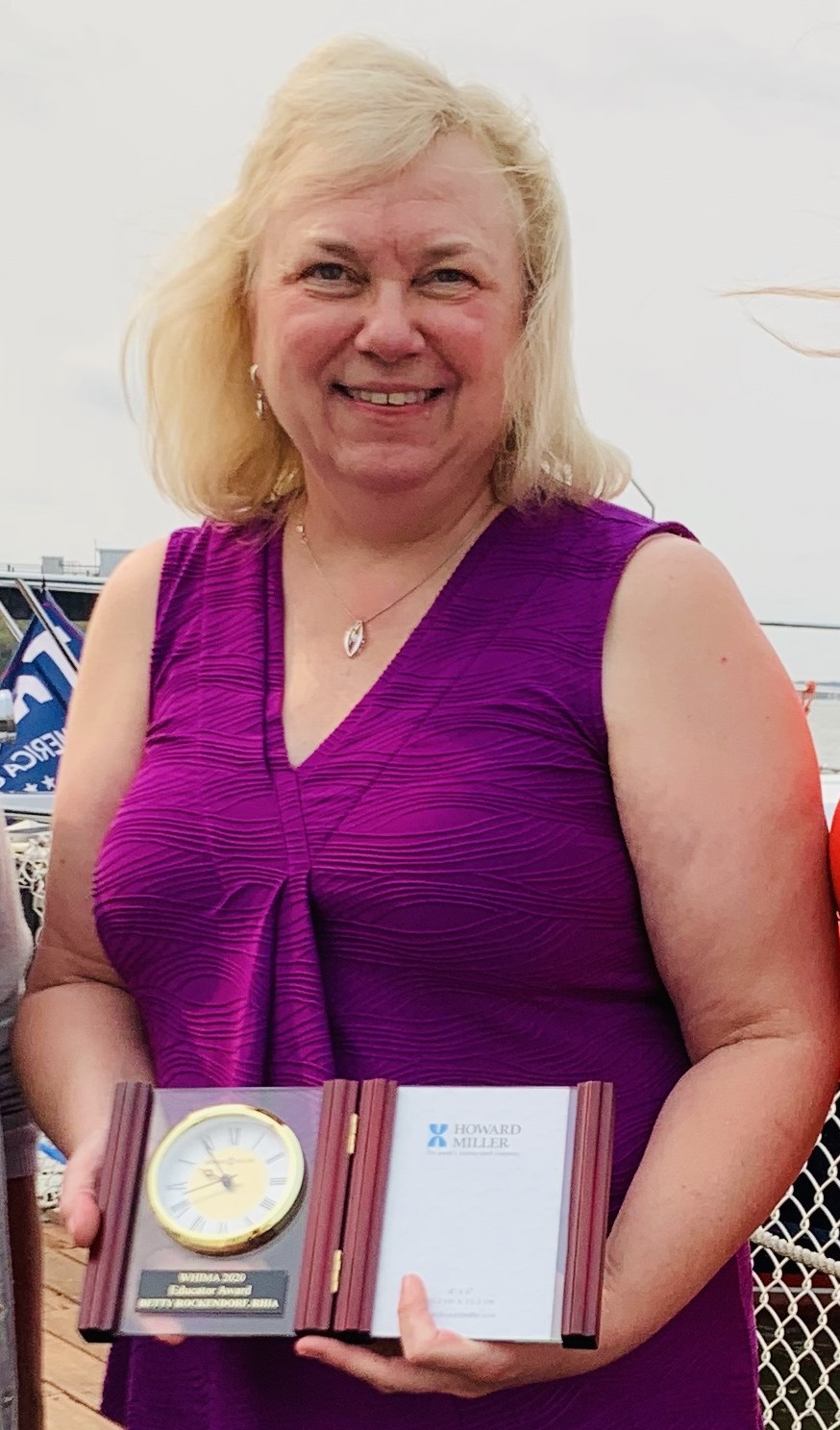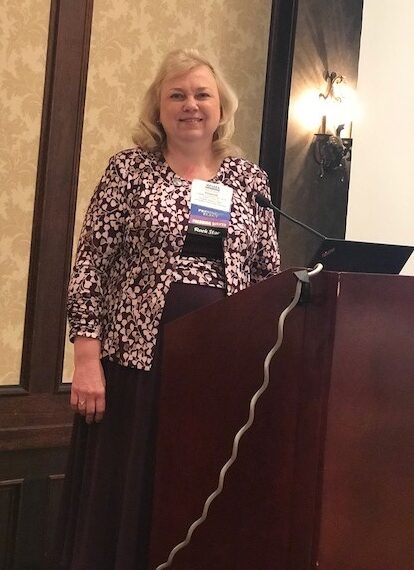Elizabeth “Betty” Rockendorf, MS, RHIA, CHTS-IM, CHPS, is a program director for the University of Wisconsin Bachelor of Science in Health Information Management and Technology (HIMT) at UW-Parkside. Like many in the 100 percent online program, Betty’s own experience with higher education began as a nontraditional student.
Betty began her career out of high school, working as a legal secretary. She worked in various secretarial roles until her 30s, when she decided to enroll in college. With no online learning options at the time, she drove 80 miles roundtrip between her home and UW-Green Bay to attend classes. She landed a job on campus, which allowed her to work and go to school in the same location while completing her Bachelor’s degree in business administration and management.
As a woman in the STEM field, Betty has had an extensive career in health information management. Her first role in healthcare was as a medical transcriptionist for the Door County Medical Center in Sturgeon Bay, Wisconsin. During her tenure, she advanced to Supervisor of Transcription and would later become the medical center’s director of health information management and privacy officer.
 During this time, Betty earned her Registered Health Information Administrator (RHIA) certification and other healthcare credentials. Wanting to go into teaching, she also took courses online and completed her Master’s degree in health information management/healthcare informatics at the College of St. Scholastica.
During this time, Betty earned her Registered Health Information Administrator (RHIA) certification and other healthcare credentials. Wanting to go into teaching, she also took courses online and completed her Master’s degree in health information management/healthcare informatics at the College of St. Scholastica.
Betty has been an instructor at UW-Parkside for eight years and teaches five courses in the online HIMT program, which is accredited through the Commission on Accreditation of Health Informatics and Information Management programs (CAHIIM). Some of her courses include:
- HIMT400: Healthcare Information and Technology—Data
- HIMT410: Healthcare Systems: Implementation and Integration
- HIMT450: Healthcare Information and Technology—Standards
RELATED: An Inside Look at a UW HIMT Course: Data Communications and Networks in Healthcare
Betty says she’s most proud of her contributions to the capstone and pre-capstone courses, where she coordinates all of the capstone placements. The capstone project gives students hands-on experience by allowing them to work with real-world clients. Some have even received job offers and earned promotions upon completing the capstone.
Whether you’re already working in healthcare or are new to the field, Betty works closely with students to ensure they have a positive experience. As a member of the American Health Information Management Association (AHIMA), she also connects with her professional network to help students find capstone sites.
“It’s been a very rewarding experience to be the capstone coordinator and instructor because, [with] our program being online, we have students in all these different states,” she said. “So I get to meet and talk with a lot of people as I work to set up these capstone internships.”
To date, more than 280 students in the course have partnered with capstone sites across 26 states.
In the following Q&A, we spoke with Betty to learn more about what students can expect from the capstone project.
What’s the most common question or concern that students have regarding the capstone?
People are nervous and anxious about it because they feel like they’re being thrown out there into the world, and they are. The goal of the UW HIMT program is to build up student skills and confidence so they can demonstrate the competencies they have learned. I can give them some pointers about what to expect, but everybody’s capstone is a little different, so there isn’t one set “This is what everybody’s going to go through.”
The reason it’s different is because the people are all different. Some have already been working in healthcare, and they might even be working in a health information management department. I’ve got other people who’ve never stepped foot in an HIM department, and so they really don’t know what to expect.
Everybody has a different capstone supervisor, too, at the facility. Some people are very involved with the student, and then others assign them to different staff members. That differs a little bit too, but I’m always here to help. So get to know your capstone supervisor, decide on a project that you’re going to work on, and then we usually meet after that.
A couple weeks into the semester, we’ll have a Zoom meeting with the capstone supervisor, the student, and myself. We talk about any questions or anything that’s come up. I would say, for almost 99 percent of the time, the students are pleasantly surprised because, again, health information management professionals—we’ve all been there. We’ve all been that student.
So they really take these students under their wing, and they really want to see them succeed. And so they’re very helpful. I think once the student sees that, then the anxiety goes away, and they start to feel a little more confident.
RELATED: Students Without Prior Healthcare Experience Can Thrive in the UW HIMT Program
When should I start preparing for my capstone project?
I am available if people have questions early on. I’m happy to schedule a time to meet with them and talk with them because that helps with their anxiety. Some students are just looking for advice too.
If they have absolutely no healthcare experience at all, they might be asking me, “Would you suggest that I try to get a job in healthcare or that I try to do some volunteer work at a local hospital?” The answer is “yes.” If you have no healthcare experience, it is very beneficial to look for volunteer opportunities early in the academic program.
I like to hear those kinds of questions, because I do think that’s a good idea for them to get started early on. By their second semester, at least start thinking about it.
Get Program Guide
Learn more about our 100% online degree and certificate programs.
What types of capstone projects have students completed in the past?
Before the electronic health record, there were all the paper files and paper charts, and there still is paper in healthcare. It’s not all electronic, because they still use a lot of scanners to scan paper documents in so that they can get it into the electronic version.
For a lot of people, when they get to the capstone, that’s something that really surprises them. I’ve had several students now who have been involved in huge projects to purge paper records. And you can’t just dispose of them because you must comply with retention laws and regulations. Depending on what kind of a facility it is, they have different retention standards.
I’ve had students that have been involved in some of these big cleanup projects, and one was just last semester. He was working for the State of Wisconsin, Department of Corrections (DOC), Division of Management Services-Bureau of Records Management. They had warehouses full of paper medical records that needed to be scanned in. That’s one agency that has to keep them for a long time, so he was involved in this large-scale scanning project, and it was very interesting.
We’ve had a few students who have been involved in delivering education to staff, like HIPAA privacy and security education. Those are always nice because it gives the student a chance to teach what they’ve learned.
Others have developed dashboard documents for HIM managers, conducted process improvement activities, created back-up plans if the electronic health record is out of service, analyzed denials from payors, audited medical coding, and contributed to a data governance plan. Students have researched and recommended plans for outsourcing operations such as release of information, or assessed the feasibility of having staff work remotely.
The list is endless, and placement is based on each student’s interests, among other factors.
RELATED: See a List of Other Capstone Projects HIMT Students Have Completed
What if my project doesn’t go as planned or something unexpected happens?
Maybe the capstone placement isn’t a good fit, and the person doesn’t really hit it off well with the site supervisor for whatever reason. In today’s world, everybody is so busy. It seems in a lot of places, people are expected to do more with less staff.
If we identify that early enough that there’s still time for me to find them another placement, I can do that. If they really aren’t enjoying their capstone placement, I can usually find them something else.
So they’re told to talk about contingency planning. If they start a project and that project just isn’t working out, or maybe the organization finds out that the funding isn’t there for a particular project to move forward, we’re very flexible because we can pick a different project.
I’ve also had organizations say, “I have a project, but I don’t know if it’s going to meet the required number of hours because the capstone is 80 hours.” My rule of thumb is to spend 40 hours working on a project, and then spend 40 hours doing some job shadowing, attending meetings, and learning what you can about the whole department or the organization.
If something isn’t working, I have meetings and get involved and see if we can make it work because it’s a last resort to have to switch to a different capstone altogether.
RELATED: Exploring Non-Clinical Roles in Health Information Management and Healthcare Administration
 What’s the number one thing you want students to know about the capstone?
What’s the number one thing you want students to know about the capstone?
The number one thing is that it’s a wonderful hands-on experience for the students. They’ve taken all these courses, and it all culminates in that final semester when they’re taking the capstone.
Especially for the students that are new to healthcare, it’s such a wonderful opportunity for them to meet the people personally, do some job shadowing, and observe all the various roles in HIM, because there’s a lot. They get to ask questions, and they get to try to determine what path they would like to take after graduation.
The field is so broad and there’s so many roles that they could do, and it’s hard for a student to say, “Well, I want to do this or I want to do that.” But after the capstone, if they’ve had a chance to really experience some of those things, they get a definite feel for what they like. And then they can say, “That’s what I want to do.” That sets them out on the path to do it.
I tell them to ask questions of the person. If they like what the clinical documentation improvement specialist is doing, just ask that person, “How did you get to this point?” And they’ll walk you through. They may have started at an entry-level position, then moved on to the next step, and perhaps somewhere along the way they had an opportunity to work on a project that led them in a different direction.
It shows people a real-life pathway. We can see that on a career map that’s available through AHIMA, but it’s always nice to talk to somebody who’s really walked the walk. And they know just what it took to get where they are.
Interested in learning more about the online University of Wisconsin Bachelor of Science in Health Information Management and Technology? Contact an enrollment adviser at 608-262-2011 or learn@uwex.wisconsin.edu.










